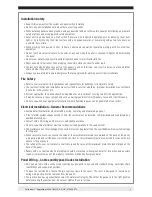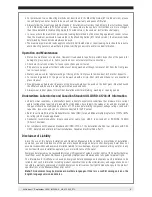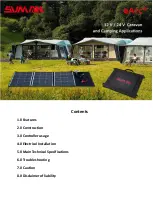
Copyright © 2009 Evergreen Solar, Inc.
5
Grounding
• Panel frames should be connected to an earth ground for safety and protection from lightning.
• The panel frame is provided with grounding holes that accommodate self-tapping screws. If grounding holes
are utilized, a #10-32 stainless steel thread cutting screw is required.
• The following specific grounding methods utilizing thread cutting screws have been successfully tested with
ES-C panels to the UL1703 standard. This does not prohibit the use of other methods, providing that the
applicable codes and standards are met.
Device
Part No.
Material
Bonding Method to Frame
ILSCO
lay-in lug
Tyco
lay-in lug
GBL-4DBT
SolKip
1954381-1
Tin plated
copper
Copper alloy
plated with tin
over nickel
• 10-32 cutting screw at grounding hole locations.
• The use of a nut is required behind the screw to create a
positive means of attachment to the frame.
Cutting
screw with
3 washers
(2 cupped,
1 star)
N/A
Stainless steel
• 10-32 cutting screw at grounding hole locations.
• The use of a nut is required behind the screw to create a
positive means of attachment to the frame.
• The grounding wire must be placed between 2 cupped
washers and around the 10-32 cutting screw.
• A star washer is required between the panel frame and the
cupped washer to ensure that the frame anodized layer is
penetrated.
• Evergreen panels can also be grounded using third party grounding washers or clip devices provided the
devices are listed and identified for grounding the metallic frames of PV panels and the devices are installed in
accordance with the manufacturers specified instructions.
Mechanical Installation
• Panels should be mounted to maximize direct exposure to sunlight and to eliminate or minimize shadowing.
• Even partial shadowing can substantially reduce panel and system output.
• Panels must be securely fastened using support frames or mounting kits specialized for PV applications.
• Panels may be mounted at any angle from vertical to horizontal orientation.
• Care must be taken to avoid low tilt angles which may cause dirt to build-up on the glass against the
frame edge.
• Dirt build-up on the surface of the panel can cause active solar cells to be shaded and electrical
performance to be impaired.
• Contact Evergreen Solar for more information regarding minimum recommended tilt angles for specific
panel products.
• For roof mounted systems, provide adequate rear ventilation under a panel for cooling (100mm: 4 in. gap
minimum).
• Clearance of 7mm:¼ in or more between panels is required to allow for thermal expansion of the frames.
• Always keep the back surface of the panel free from any foreign objects or structural elements which could
come into contact with the panel, especially when the panel is under mechanical load.
• Ensure panels are not subjected to wind or snow loads in excess of the maximum permissible loads and are
not subjected to excessive forces due to thermal expansion of the support structure.
• Evergreen Solar permits several different mounting methods. The permissible mounting methods and
maximum permissible wind and snow loads are detailed in the Mounting Guide available from Evergreen
Solar (ETL listed version).





























